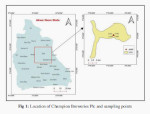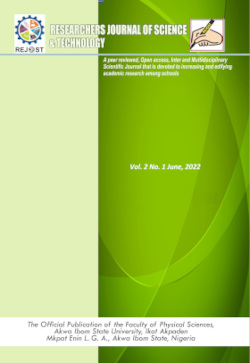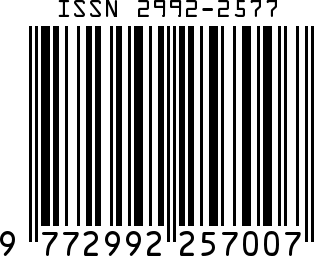Assessment of Heavy Metals Concentration in Soil of Champion Breweries Plc, Aka Offot, Uyo, Southern Nigeria Using X-Ray Fluorescence Technique
Keywords:
X-Ray Fluorescence (XRF) technique, heavy metals, soil pollution, enrichment factor (EF), geo-accumulation index (Igeo), contamination factor (CF)Abstract
The contamination of heavy metals present in soil of Champion Breweries Plc, Aka Offot, Uyo, in Southern Nigeria was assessed. In application of XRF techniques, seventeen (17) heavy metals, namely potassium (K), calcium(Ca), titanium (Ti), vanadium (V), chromium (Cr), manganese (Mn), iron (Fe), nickel (Ni), copper (Cu), zinc (Zn), gallium (Ga), arsenic (As), bromine (Br), rubidium (Rb), strontium (Sr), yttrium(Y), and zirconium (Zr), were determined from each of the soil samples obtained at four (4) sampling sites. Fe had the highest concentration in all the sampling sites in the range of 17320.0 – 29380.0 ppm and Ga had the lowest concentration in all the four-sampling site, ranging from 8.16 – 62.713 ppm. Co was only detected in one sampling site. The Enrichment factor (EF), geo-accumulation index (Igeo) and contamination factor (CF) were used as pollution indices to assess the toxicity threat posed on that part of the ecosystem by the investigated heavy metals. The results of the three pollutions indices were similar, indicating that the part of the industry was highly polluted with Cr, Rb, Zr, Zn, and Mn, Pb at some point. These high inputs of the heavy metals might be due to pronounced anthropogenic influences around the studied area. Analysis of multivariate statistics such as Pearson’s Correlation coefficient and cluster analysis were also applied to ascertain the relationship and sources of investigated heavy metals. Both positive and negative correlations were observed among some heavy metals. Rb was observed to have a strong positive correlation with As, Ga, Zn. Ti has a strong negative correlation with Cr, Br, Rb and a strong positive value with Fe and Zr which suggest that these elements are from the same origin. Low correlation between Ca -As, Ga - Zr, Mn – Rb, etc suggest that they come from different sources. Cluster analysis revealed two main clusters, this shows that elements in each of the cluster can specifically be said to come from the same source.
References
Ackerman F (1980) A procedure for correcting the grain size effect in heavy metal analyses of estuarine and coastal sediments. Environ. Technol Lett 1: 518-527.
Aksu, A. E., Yasar, D and Uslu, O. (1997). Assessment of Marine pollution in Izmar Bay: Heavy Metal and Organic Compound Concentration in Surficial Sediments. Department of Earth Sciences, Center of Earth Resources Research Memorial University of Newfoundland, St. John’s
Newfoundland, Canada A1B3X5
Birch, G., (2003). A scheme for assessing human impacts on coastal aquatic environments using sediment source.
Cai D., Zhang, H., Shen, D., Zhao, X., Li, C. (2009). Environmental changes record derived from sediment cores in Huixian Karst wetlands, Guilin, China. J. Guangxi Norm. Univ. Nat. Sci. Ed, 27, 94–100.
Chakravarty, M., and Patgiri, A.D., (2009). Metal pollution assessment in sediments of the Dikrong River, NE India. J. Hum. Ecol., 27(1): 63-67.
Champion Breweries Plc annual report (2021)Ekaete, A. J., Ibironke, O., K., Olatunde, P. S. & Olaoye, O. P. (2015) HeavyMetals pollutions and its associated Ecological Risks in Lagos Lagoon Sediments, Southwestern Nigeria. ACSJ, 9 (3), 20334
Ene A., Popescu I. V., & Stihi C, (2009). Applications of proton-induced X-ray emission technique in materials and environmental science, Ovidius Univ. Ann. Chem. 20 (1), 35.
Fusion, J. (1999). What Is Soil Pollution? Available at http://www.ehow.com/about 5107995 soilpollution html, accessed February 2, 2009.
Hakanson I., (1980): Ecological risk index for aquatic pollution control, a sedimentological Approach. Water resources,14; 975- 1001.
Ho, H. H., Swennen, R., Damme, A.V., (2010). Distribution and contamination status of heavy metals in estuarine sediments near Cua Ong Harbour, Ha long Bay, Vietnam. Geol. Belgicia. 13/1-2: 37-47.
Klerks P. L, and Levinton J. S, (1989) Rapid evolution of metal resistance in a benthic oligochaete inhabiting a metal-polluted site. Biol Bull 176: 135-141
Loring D. H, Naes K, Dahle S, Matishow G. G, & Illin G (1995) Arsenic, trace metals, and organic micro contaminants in sediments from the Pechora Sea, Russia. Mar Geol 128: 153-167
Liu D., Li Y., Ma J., Li C., Chen X., (2016). Heavy metal pollution in urban soil from 1994 to 2012 in Kaifeng City, China. Water Air Soil Pollut, 227, 154. [CrossRef]
MacDonald, D. D., Ingersoll, C. G. and Berger, T. A. (2000). Development and Evolution of Consensus -Based Sediment Quality Guidelines for Freshwater Ecosystem Archives of Environment and Contamination Toxicology, 39: 20-31
Muller, G. (1969). Index of Geo-Accumulation in Sediments of the aaaaarhine River Geo. J., 2(3): 108-118.
Müller G (1981). Die Schwermetallbelastung der sedimente des Neckars und seiner Nebenflusse: eine Bestandsaufnahme. Chem Ztg 105: 157-164
Pantelica A., Cercasov V., E. Steinnes, P. Bode, & B. Wolterbeek, (2008) Investigation by INAA, XRF, ICPMS and PIXE of Air Pollution Levels at Galati (Siderurgical Site), Book of abstracts, 4th Nat. Conf. of Applied Physics (NCAP4),
Galati, Romania, September 2008 (A. Ene –Editor). Galati University Press, Galati, Romania.Popescu I.V.,
Stihi C., Cimpoca Gh.V., Dima G., Vlaicu Gh., Gheboianu, Bancuta I., Ghisa V., & State G. (2009): Environmental Samples Analysis by Atomic Absorption Spectrometry (AAS) and Inductively Coupled Plasma-Optical Emission Spectroscopy (ICP-AES), Rom. Journ. Phys. 54 (7–8), 741.
Praveena, S. M., Radojevie, M., Abdullah, M. H., Aris, A. Z., (2007). Factor –cluster analysis and enrichment study of mangrove sediments- An example from Mengkabong Sabali. The Malaysian J. Analytical Science 2(2): 421-430
Praveena, S. M., Ahmed, A., Radojevic, M., Abdullah, M. H., Aris, A. Z., (2008). Heavy metals in mangrove surface sediment of Mengkabong Lagoon, Sabah: Multivariate and geo-accumulation index approaches. Int. J. Environ. Res., 2(2): 139-148.
Stihi C, A. Bancuta, I.V. Popescu, M. Virgolici, V. Cimpoca, M. Gugiu and Gh. Vlaicu, (2006) Air pollution studies using PIXE and ICP Methods, Journal of Physics: Conference Series 41, 565.
Stihi C, Popescu I.V., Gheboianu A., Frontasyeva M., Ene A., G. Dima, O. Bute, V. Cimpoca, V. Stihi, C. Oros, S. Dinu, M. Voicu (2008). Mineral Content of Native Vegetables Obtained by Energy Dispersive X-ray Fluorescence Spectrometry, Journal of Science and Arts, 9 (2), 332.
Suciu I, C. Cosma C., Todica M., Bolboaca S. D., & Jantschi L., (2008). Analysis of soil heavy metal pollution and pattern in Central Transylvania, Int. J. Mol. Sci. 9, 434
Veerasingam, S. Venkatachalapathy, R. & Mohan, R. (2010). Assessment of Trace Metals in Petroleum Hydrocarbons Contamination in Marine Sediments off Chennai, Bay of Bengal, India International conference on Recent Frontiers in Applied Spectroscopy, Department of Physics Annamalai University, India.
Vries W. de, Romkens P.F., & Schutze G. (2007). Critical soil concentrations of cadmium, lead, and mercury in view of health effects on humans and animals. Reviews of Environmental Contamination and Toxicology 191, 91.
Zhang J, Liu CL (2002). Riverine composition and estuarine geochemistry of particulate metals in China-weathering features, anthropogenic impact and chemical fluxes Estuar Coast Shelf Sci 54: 1051-1070.

Downloads
Published
How to Cite
Issue
Section
Categories
License

This work is licensed under a Creative Commons Attribution-NonCommercial-NoDerivatives 4.0 International License.




